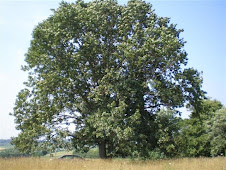Common questions/misperceptions:
1) "Isn't that going to be a fire hazard?"
No.
Strawbales are very densely packed and therefore don't have air flowing all around them to fuel a fire. Strawbale homes are inherently less flammable than a 'normally' built home.
Burning a strawbale would be like burning a telephone book. Burning a conventionally-built wooden home is more like burning a sheet of paper.
2) "Won't cows come by and eat your house?"
Not likely unless they have that mad cow disease or something.
For those who are unfamiliar with farming and countryside-type stuff: Straw is usually used BEDDING for animals; they lay on it to sleep and such. Hay is FOOD for animals; food is what animals and people eat. Apparently, straw can be mixed in with food for added roughage etc., but this is not a common practice (and can make them that eats it constipated!).
http://en.wikipedia.org/wiki/Straw
3) "What about water and rot?"
Kind of a personal question don't you think?
The straw bales will be covered with natural plaster inside and out. Plaster will 'key in' directly to the bales (lots of surface area!) and will be vapor permeable. Even so, Sigi has incorporated flashing details etc. that are designed to reduce the likelyhood of water infiltration. Some people use expanded wire lath on the bales and have the plaster key to that - I think that's not such a good idea. As far as I'm concerned, adding a physical layer of lath is introducing one more possible failure.
4) "Won't the Big Bad Wolf come and blow your house down?"
No.
This is a children's story and there aren't many wolves in Northern Harford County...just a few coyotes and foxes with limited lung capacity. Even if there were wolves (with attitude problems), I think they'd be smart enough to use heavy equipment to destroy things.
5) "What about rodents?"
The strawbales will be coated with a natural lime plaster. Lime (calcium carbonate) plaster is highly alkaline and would tear up one's guts. I don't know for sure, but I'm pretty convinced that any animal that ate this stuff might be, at the least, very ill...and dehydrated.
When Craig & I decided to build a new house, we both decided that we wanted to be as responsible, as environmentally conscious, and as sustainably-minded as was practicable. I initially told him not to worry because, "I'm not 'crazy' enough to want to build a strawbale house!" Apparently, I am.
Why Build a Strawbale House?
We found our architect, Sigi Koko, online. We liked the examples of things she'd done and her approach to design and building. I was also fond of the list of books she recommended on her website - several of which I'd already read.
Meeting with Sigi, we discussed various approaches and options, and after asking many, many questions, I/we decided that strawbale construction wasn't so crazy after all!
Strawbales:
1) can be sourced locally
2) are very sustainable - you can grow more very quickly, they are compostable, and don't need a lot of fossil fuels to grow!
and...
3) are insanely good insulation
skip to main |
skip to sidebar
+(Small).jpg)
"First Pig" is a blog dedicated to tracking the construction of our strawbale house in Harford County, Maryland. The title refers to the story of The Three Little Pigs, the first of whom built his house out of straw. My husband Craig and I, and Jeff Geddes, our builder (Paragon Custom Homes, LLC), will be updating posts and pictures of our progress.
Search This Blog
Our tree: Half red oak, half white oak
+(Small).jpg)
